This is the quarter’s task sheet that includes:
- The links (global context, key concept, related concept, statement of inquiry, and inquiry questions), assessment description task
- ATL (Approaches to Learning) skills
- A few keywords (with more added on later on this post)
- The rubric use to grade the product with specific description
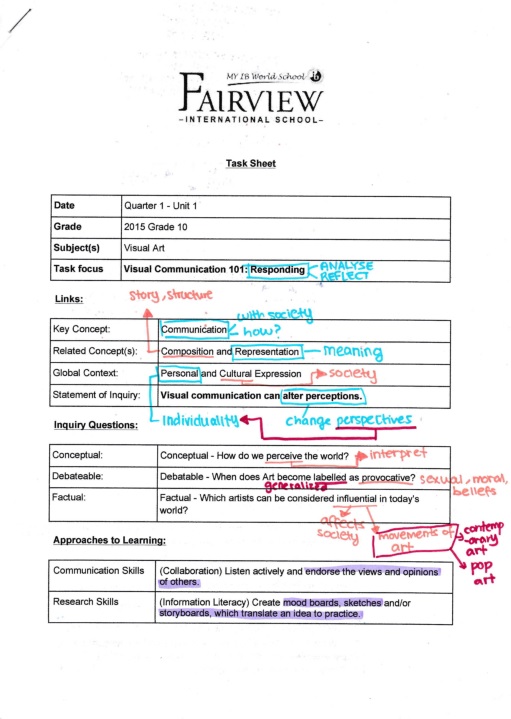

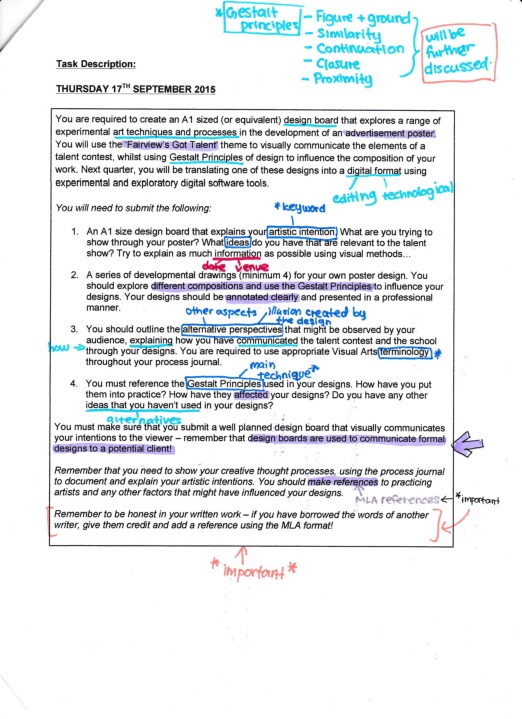
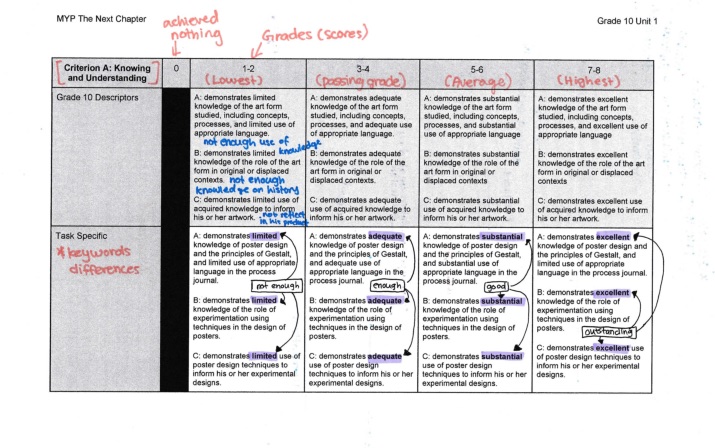

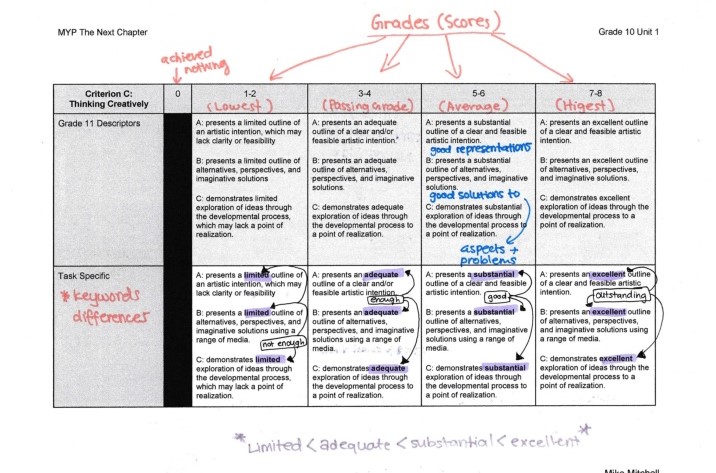

CONTEMPORARY ART
We had to create a 4-section mind-map where the first and third section are our thoughts on 2 artworks solely based on our aspects and perspectives, without having to know its title or the artists’ name.
The first installation art was by Tracy Emin, titled “Everyone I Have Ever Slept With” (1995):

Our first respond was that the artist wanted to show her memories of her during the period of her life (specifically 1963 – 1995). We figured that the content inside the are names of people, so she’s trying to share her experience through her highlight of life when she enjoy most, hence the vibrant, yellow colour to represent her passion for these people. But with the calm and cooler tone of dark blue of the tent, we thought that she only wanted to keep these memories to herself or it represents how the memories was a passionate past-memories that she brought back.
After we discussed it among our group members, we shared our first thoughts with other groups as they did with us. The artwork’s title and artist’s name was then revealed; and as soon as the title was revealed, we supposedly immediately got what the work was about. We then wrote our impression on the second part of the poster:

Even after knowing the title, it was pretty much the same as we had expected it to be: about showing her inner thoughts of joyous memories. The tent represents the limited space that she had to acknowledge herself in terms of her privacy; a place where she could open up, and be honest to the herself without being judged.
Then after a few minutes we shared our after-thoughts to our class once again and one group especially caught my attention, which said that they interpreted that the names of the people she slept with was her friends, family and anyone related to her. They interpret that It was literally everyone she ever slept with. It was amusing how most of us immediately thought of sexual subject when we saw the words ‘slept’. That’s why I mentioned that when we saw the title, we supposedly know what the artwork is about. It’s a wordplay where artists use a choice of words in the title to confuse the audience, questioning our vocabulary and our knowledge. We always thought of the word ‘slept’ in a sexually manner and also in a negative manner, but in Britain, the word ‘slept’ is literally sleeping with someone in not a sexually manner.
Next we looked at the second artwork by Damien Hirst, titled “The Physical Impossibility of Death in the Mind of Someone Living”(1991).

Our first impression on this artwork is that the shark that is divided into three parts represent the parts of a story, or maybe how the box limited the movements of the shark; representing being caged or trapped in a place. We as humans sometimes over think; thinking how the event happened how we presume it be, but it is not actually what you thought it be. So we humans have to overlook the facts, which are replaced by emotional thoughts related to it – this causes misunderstandings between people. We thought about this when analysing the artwork.
Just like before, we shared our analysis and thoughts on the picture with other groups again. It was then revealed the title and also the artist’s name.
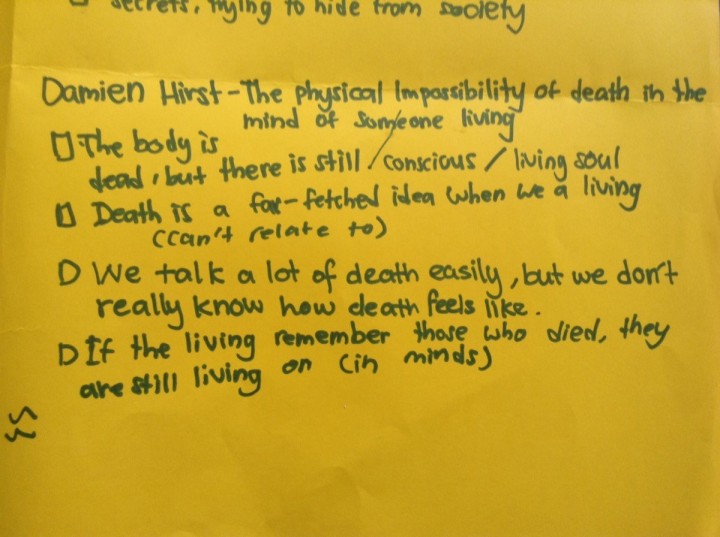
This time, our perspective was quite different to how the title is named. It was quite confusing how the title are actually associated with the artwork. But think that the shark is the perception of “a living death” where the body is present and dead, but there is still a conscious and living soul; this means that the idea of death is still far-fetched when we are still living. We don’t know how it feels like to actually die – nobody does, and it’s not like we could ask a dead person how it feels like.
So we human know about the idea of death and we know that we are going to experience it sooner or later, however it is still a physical impossibility to experience death, even though we talk about it often.
Today I’ve learned about how contemporary art are applied today and how it changes the mediums of a usual-painting medium of oil-paint or watercolours.
I’ve also learned how titles of artworks alone can change the perspective and visual aspects of our interpretation by the choice of words. The title changes the mood and atmosphere of the artwork as whole, giving a new meaning of some sort. The choice of words makes the audience adjust the perspective that is associated to the work with the title, which I think the title gives out the connection between the artist’s artistic intention to the artwork (hidden messages).
KEYWORDS
- Abstract – a style of art that uses different elements of arts to express emotion, mood idea (individuality); rather than a historical or realistic aspects.
- Abstract Expressionism – by using the elements of art, artistes fills a large canvases with many skeptical ways and techniques. These characteristics are different as they are more towards nonrepresentational shapes to create imagery, but rather a more organic aspects.
- Appropriation – taking inspirations of images or forms to create another innovation/idea.
- Chiaroscuro – an Italian word that means ‘light-dark.” The techniques uses the concept of the effects of light and shadows on from through the contrast of light and dark areas. These techniques are applied in painting, drawing, and graphic arts.
- Collage – a work composed of different medias (photographs, other objects) together.
- Composition – using the elements of art to create a work of art.
- Conceptual Art – the art that mostly are focused on the idea or concept than the finished art object.
- Contemporary – the present (21st century) period of time.
- Found Objects – objects such as bottles, scraps of vinyl, fabrics, or metals that does not have any artistic value that are used in an artwork.
- Iconography – studying the representation and meaning of a subject matter.
- Installation – An artwork that uses space (usually 3D-like) to create an environment to get the audience involved.
- Juxtaposition – To compare and contrast two different objects in order to create meanings of existing images or ideas.
- Medium – the material used by an artist to create his/her artwork.
- Minimalism – An art movement characterized by organic (free-flowing) forms and shapes instead of abstract structures and geometric forms. It started during the 1960s by a group of New York City artists.
- Performance Art – Live, theatrical performance based artwork.
- Pop Art – an art movement that uses common objects and branded products to reflect on the popular culture and also to address social issues.
- Popular culture – the media, television, movies, and fashion of contemporary society.
- Postmodern – an art movements to rebel against the modernized art that was popularized during the 1970s. It rejects the idea of landscape and and historical paintings, and optimism. They are mostly influenced by pop art, conceptual art, and feminism culture. It is characterized by appropriation, pastiche, irony, and the use of non-traditional mediums such as fabric, furniture, and video.
- Representational – relation to representation/meaning (what it means).
- Site-specific Art – any artworks that are designated to a specific location.
- Storyboard – different images to use inn planning the shots for a video.
REFERENCES
- Art21.org,. ‘Contemporary Art In Context | ART21’. Web. 15 Aug. 2015.
- Emin, Tracy. Everyone I Have Ever Slept With. 1995. Installation Art.
- Hirst, Damien. The Physical Impossibility Of Death In The Mind Of Someone Living. 1991. Installation Art.


